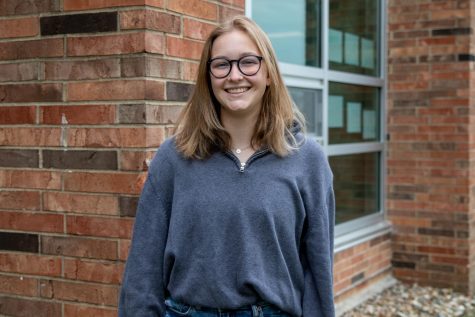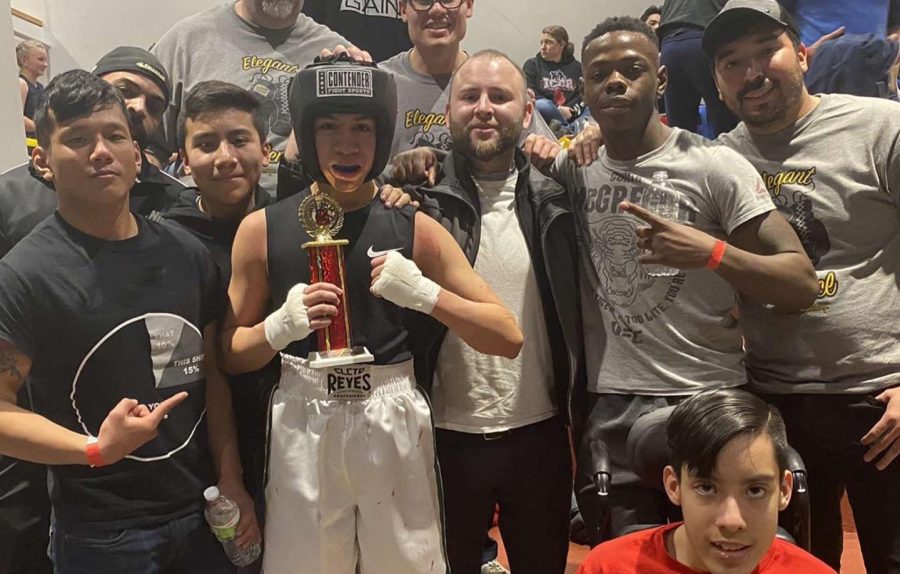Stepping into the ring
Sophomore Erik Caperon has been throwing punches since he was a child, and his boxing journey is just beginning.
Erik Caperon stands with his team after winning a state title.
Jab, cross, slip, hook, repeat. These rhythmic movements fill Big George’s Gym, second home to Erik Caperon ’24. In this gym, he learned discipline, control, and perseverance.
“My dad is a former boxer, so he started training me at a young age,” said Caperon. Having a father in the fighting world has made Caperon’s connection to the sport personal, adding an additional pressure. Around the age of ten Caperon struggled to find some personal motivation, but in recent years has started to fall more in love with the sport.
Despite being pushed into the sport, Caperon has no regrets. “I’m glad that I was pushed into it. Because it is such a unique sport, you know, not a lot of people do it. And that’s actually a really cool thing to say,” said Caperon.
He elaborated on what helped him find his own passion for his father’s sport. “Boxing is a very unique sport. It’s just really nice to be around people like that,” said Caperon. His love for the environment is clear when looking at his training schedule. He spends up to three hours a day at the gym, Monday through Thursday with occasional additional sparring on weekends. This is where the discipline comes in, putting time and effort into such a physically taxing sport.
“Just being around other people helps you work harder, to try to out beat the person. [With] your teammates, you can spar with them to make you better or make them better. It’s more of a team sport than it is individual, to be honest,” said Caperon.
Boxers come in many different shapes and sizes, with a wide range of fighting styles. For example, Mike Tyson fought with aggressive defense, keeping his opponent away from him while racking up points with good, clean shots. Muhammed Ali used his footwork to keep his opponents on their toes and used his speed to throw punches before his opponent knew what hit him. Caperon has a self-proclaimed aggressive fighting style, looking to “go in for the kill.” Stance is another important part of boxing.
An orthodox fighter leads with their left shoulder while a southpaw leads with their right. Most fighters are orthodox, with one survey finding that only 17% of professional male boxers are a southpaw. “Naturally, I was an orthodox, but recently, like this year, I started switching. It was more natural to me. My coach helped me out with a lot of footwork,” said Caperon.
Boxing isn’t the only sport that Caperon is involved in, having participated in the previous football season. The breath control and ability to read another’s body language that he acquired from boxing easily translated into the skills necessary for football. The skills he picked up from football also added to his ability as a boxer.
“My hand-eye coordination is a lot faster than others. I feel like my footwork’s a lot better. [I] just feel a lot quicker and faster,” explained Caperon.
Being involved in multiple contact sports has caused Caperon to be no stranger to injuries.
“I recently tore something in my wrist, and also had surgery because of boxing. I got a concussion. But it wasn’t really that bad,” said Caperon.
The surgery was extremely minor with a quick recovery time, leaving Caperon feeling better than before. The more concerning injuries to athletes like him are concussions and other Traumatic Brain Injuries. Chronic Traumatic Brain Injuries occur in 20% of professional boxers. Caperon is preparing for a long career in boxing and is taking preventative measures.
“I’ve been working a lot of head movement. So I don’t really get hit as much, I try to give more of the contact than taking the contact,” said Caperon. “My coach makes me stretch, like a lot. And we do a lot of neck workouts and jaw movements. I’m literally forced to chew a lot of gum so I can strengthen my jaw. So I don’t really get knocked out,” said Caperon. Strengthening the neck and jaw can help a boxer take impact safely and decrease the chance of being knocked out.
Drills like these can account for Caperon’s up to 40 fight record and mere three losses. He has one state title under his belt and is looking to add more. This ambition has caught the eye of professional clubs.
“I already have a bunch of pro boxing gyms who want to sign a contract with me when I turn eighteen,” said Caperon. Despite the local offers, he currently intends to move out of state before signing with a gym.
Caperon plans to continue schooling while pursuing his fighting career. With professional clubs already taking an interest in his future, it is likely that regardless of where Caperon furthers his education, he will be able to continue his aspirations.
One thing that Caperon can’t fight in the ring is the public perception of physical sports like boxing.
“Usually, [boxers are] completely different people inside the ring than outside of the ring. On the inside, you can be aggressive in the ring. You can also be passive in the ring, you know, you don’t always have to be angry,” said Caperon.
Upon learning that he is a boxer, Caperon is often faced with preconceived notions of aggression.
“They’ll think that I’m willing to fight anyone. That’s not what I’m here for, I’m not always trying to fight someone,” he said.
Caperon had some advice for anyone looking to improve themselves in their sport. “If you feel really committed to it, you have to stick to it, stay on it every day, because if people come in every day, and you skip a day, they’re one step ahead of you. So you have to be ready. Stay with it,” said Caperon.
Your donation will support the student journalists of West High School. Your contribution will allow us to purchase Scholarship Yearbooks, newsroom equipment and cover our annual website hosting costs.

(she/her) Maddy Smith is a senior at West. This will be her third year on staff. She is the online Features and Visuals editor. She enjoys music, photography,...



